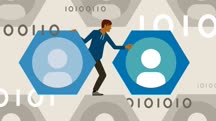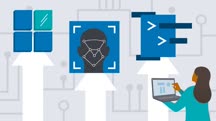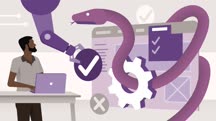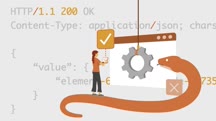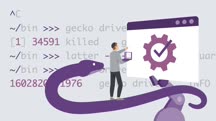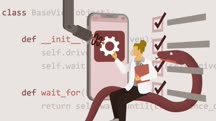Course catalog
Categories
Showing 1,301-1,320 of 1,450 items.
Team Collaboration in Office 365 (Microsoft 365) (217767)
Microsoft 365, formerly known as Office 365, offers the latest Office apps and features for communication, file sharing, and project planning. The apps in Microsoft 365—Word, Excel, PowerPoint, Outlook, Teams, and more—are designed with collaboration in mind, yet many users aren’t leveraging all that these tools have to offer. In this course, Nick Brazzi offers tips for maximizing team productivity in Microsoft 365. Nick covers working with shared calendars in Outlook, connecting with your colleagues in Teams, and managing files that have been shared in Teams (as well as accessing those shared files in tools like SharePoint and Outlook). Plus, get tips for communicating more efficiently using Groups, using file libraries in SharePoint, sharing notes and files via OneDrive, creating shared tasks and projects in Planner, and more.
Tech Career Skills: Communication for Developers (230585)
The work of developers doesn’t stop when code is committed. You need to help others understand the value of what you do—and why. This course examines the barriers between technological concepts and nontechnical audiences and proposes ways to overcome them. It identifies four major kinds: barriers of experience, motivation, perspective, and style. Instructor and communicator Tom Geller explains how to recognize these barriers and adapt your message to meet your audiences in the middle. He also examines specific opportunities to put your new skills into practice: with clients, vendors, team members, partners, conference audiences, and members of the public. The skills you learn in this course can benefit your career and your daily life. Discover how to overcome differences, strengthen your relationships, and promote your work by communicating in a way that everyone can understand.
Tech Recruiting Foundations: 1 Introduction (215642)
Tech is one of those rare places where demand for jobs is higher than the supply. With that in mind, how can recruiters and hiring managers get the best candidates for the job into the jobs they’re trying to fill? One way is by understanding the tech well enough to know exactly what you need. In this series of courses, instructor Ayub Shaikh goes over high-level IT concepts and breaks them into related, easy-to-remember groupings. This course introduces you to the series. Ayub defines critical terms and trends that you will need to understand, then explains how and why IT recruitment got started. He covers what IT is, shows you the basic structure of IT roles, and describes hardware and the specific skills that specific hardware may require.
Note: This course was created by Holistica Consulting. We are pleased to host this training in our library.
Note: This course was created by Holistica Consulting. We are pleased to host this training in our library.
Tech Recruiting Foundations: 2 Understanding Hardware and Operating Systems (219960)
Tech is one of those rare places where demand for jobs is higher than the supply. With that in mind, how can recruiters and hiring managers get the best candidates for the job into the jobs they’re trying to fill? One way is by understanding the tech well enough to know exactly what you need. In this series of courses, instructor Ayub Shaikh goes over high-level IT concepts and breaks them into related, easy-to-remember groupings. This course focuses specifically on hardware and operating systems. Ayub shows you a variety of hardware that may impact what skill set you need for an IT position, such as PCs, servers, mainframes, supercomputers, serverless API frameworks, and more. He explains operating system specifics, including what an operating system does, open and closed systems, and how Linux differs from other operating systems.
Note: This course was created by Holistica Consulting. We are pleased to host this training in our library.
Note: This course was created by Holistica Consulting. We are pleased to host this training in our library.
Tech Recruiting Foundations: 3 Recruiting Software Developers (219858)
Tech is one of those rare places where demand for jobs is higher than the supply. With that in mind, how can recruiters and hiring managers get the best candidates for the job into the jobs they’re trying to fill? One way is by understanding the tech well enough to know exactly what you need. In this series of courses, instructor Ayub Shaikh goes over high-level IT concepts and breaks them into related, easy-to-remember groupings. This course focuses specifically on recruiting software developers. Ayub explains what makes up application software and what developers, engineers, and other titles actually do. He also covers differences between recruiting front-end developers and recruiting back-end developers.
Note: This course was created by Holistica Consulting. We are pleased to host this training in our library.
Note: This course was created by Holistica Consulting. We are pleased to host this training in our library.
Tech Recruiting Foundations: 4 Recruiting for the IT Department (219875)
Tech is one of those rare places where demand for jobs is higher than the supply. With that in mind, how can recruiters and hiring managers get the best candidates for the job into the jobs they’re trying to fill? One way is by understanding the tech well enough to know exactly what you need. In this series of courses, instructor Ayub Shaikh goes over high-level IT concepts and breaks them into related, easy-to-remember groupings. This course focuses on how you can recruit successfully for an IT department. Ayub introduces you to the roles that exist in the modern IT department, as well as internal and outsourced needs. He walks you through finding cloud-capable candidates and exploring the different silos into which IT roles are often grouped. Ayub concludes this course with a discussion of some caveats and considerations that you may encounter for networking and ops roles.
Note: This course was created by Holistica Consulting. We are pleased to host this training in our library.
Note: This course was created by Holistica Consulting. We are pleased to host this training in our library.
Tech Recruiting Foundations: 5 Waterfall, Agile, and DevOps for Recruiters (219841)
Tech is one of those rare places where demand for jobs is higher than the supply. With that in mind, how can recruiters and hiring managers get the best candidates for the job into the jobs they’re trying to fill? One way is by understanding the tech well enough to know exactly what you need. In this series of courses, instructor Ayub Shaikh goes over high-level IT concepts and breaks them into related, easy-to-remember groupings. This course focuses specifically on waterfall, agile, and DevOps. First, Ayub explains the waterfall model, its strengths, its drawbacks, and how those drawbacks led to the development of the agile model. Next, he introduces you to the agile manifesto, key principles of agile development, and how you can identify and recruit agile candidates. Ayub concludes with a discussion of devops, including how it combines two separate silos of IT skills and how you can find and recruit devops candidates.
Note: This course was created by Holistica Consulting. We are pleased to host this training in our library.
Note: This course was created by Holistica Consulting. We are pleased to host this training in our library.
Tech Trends (218005)
Get a rundown of the latest tech trends from our very own LinkedIn staff instructors. Whether you're a software engineer wondering if a new feature or update is worth your time—or a technology manager determining which services or products to adopt—this course offers the information you need to quickly assess emerging trends.
Each video works as a stand-alone explainer, so you can watch the course in order or cherry-pick your favorites. Get insights on hot topics like facial recognition, Android apps on Windows 11, and much more. And as exciting new technologies emerge, we’ll add new videos to this course to keep you on the cutting edge.
Each video works as a stand-alone explainer, so you can watch the course in order or cherry-pick your favorites. Get insights on hot topics like facial recognition, Android apps on Windows 11, and much more. And as exciting new technologies emerge, we’ll add new videos to this course to keep you on the cutting edge.
Technical SEO (209913)
Even if the only thing you know about SEO is what the letters S, E, and O stand for, you probably know that good content on your website only goes so far when it comes to improving visibility. In order to maximize ROI and increase leads to your business, you need technical search engine optimization. In this course, Dana DiTomaso shows how to optimize your website for SEO by looking at how crawlers work, strategies for increasing site speed, using schema, architecture, URLs, and image/video to your SEO advantage. In addition to the actual nuts and bolts of SEO, Dana also covers the importance of making concrete recommendations to web developers, so you can actually get the fixes implemented.
Technology and Design Ethics (205561)
Many of the technology courses in our library focus on how to make things. But sometimes, designers and developers need to pause, look around, and evaluate how the things they make affect the people who'll end up using them. "What's best for our users?" can be a difficult question when mixed with other organizational priorities. In this course, Morten Rand-Hendriksen provides concrete approaches for evaluating and acting on the ethical questions technologists encounter constantly. He provides a framework for ethics in tech, discusses matters related to privacy and security, explains how to discover and define virtues, and more.
Telling a Story to Build a Community (224907)
Do you need to build a following or grow your community? No matter how many facts you rally in support of a cause, they will never hold the same weight as a well-told story. In this course, Michael Kass, founder of StoryImpact, explains how to identify and craft your story in order to create change in the world. Learn about the different types of stories that can be told and the key ingredients of a successful story. Discover how to structure your elements into a story that engages your audiences and rallies them around your call to action, whether that’s to donate, volunteer, or simply spread the word. Finally, discover different ways to deploy your story, both online and in person.
This course was created by CreatorUp. We are pleased to host this content in our library.
This course was created by CreatorUp. We are pleased to host this content in our library.
Telling Your Story on the Web in 60 Seconds (222731)
Grabbing people's attention on the internet is getting harder and harder. Simple text and static photos just don't cut it in such a cluttered space. In this course, you learn how to use video, motion graphics, and 360-degree imagery to create eye-catching content. Rich Harrington takes you through a dozen step-by-step projects that feature dynamic media—from the deceptively simple slideshow to meme-worthy animated GIFs to attention-grabbing videos for TikTok—and require nothing more than a camera or smartphone and a subscription to Adobe CC and a few downloadable apps. Each project can be exported in a format that's easy to share online and on social media. By the end of the course, you'll have several options for building your next web project, whether it's to demo a product, draw attention to a cause, or promote a brand online.
Test Automation with Python: 1 Introduction to Automated Testing (220402)
The Test Automation with Python series from Headspin University is designed to teach automation skills and tools for testing applications in Appium and Selenium, the world's most popular UI automation tools. But before getting into the automation itself, this first course delves into the concept of testing, from the etymology of the word, to how to design useful tests for your software. While using software as it is meant to be run seems like an obvious test, it’s also helpful and necessary to imagine conditions for the software that its developers might not have thought about. The history of automation is also covered, highlighting the fact that most software is in fact a form of automation. After this course, you’ll have a solid foundation of automated testing and be ready to move on to the next course in the series.
Note: This course was created by HeadSpin University. We are pleased to host this training in our library.
Note: This course was created by HeadSpin University. We are pleased to host this training in our library.
Test Automation with Python: 10 Additional Appium Modes and Features (226369)
This installment of the Test Automation with Python takes a look at scaling your test suite so that you can run multiple tests at a time. Eventually your test suite will grow large enough that waiting for tests to complete one by one just doesn’t make sense. This course covers the complications that come with running multiple tests in parallel and details what you need to successfully run your test suite. And while running your tests in an isolated environment is an important part of the process, this course demonstrates the importance of testing them out in a continuous integration environment as well. The course finishes with techniques for debugging your tests, along with best practices for speed, reliability, and maintainability in your test suite.
Note: This course was created by HeadSpin University. We are pleased to host this training in our library.
Note: This course was created by HeadSpin University. We are pleased to host this training in our library.
Test Automation with Python: 2 Python for Testers (220419)
This second course in the Test Automation with Python series focuses on writing code to automate software testing. As opposed to no-code tests where you record your actions in an app for later playback, writing code for automation gives you more flexibility in many cases, such as when a small change to the app causes the testing process to change. This course also explains the choice of Python as the programming language. While Java is probably the most popular language used with Selenium and Appium, it can lead to unnecessary complexity and confusion unless you know it well. Python, meanwhile, is powerful, simple, and expressive, and in some ways is more flexible in terms of executing UI test automation. This course walks you through the entire process, from installing Python, to writing your first script, all the way through completion, testing, and troubleshooting your code.
Note: This course was created by HeadSpin University. We are pleased to host this training in our library.
Note: This course was created by HeadSpin University. We are pleased to host this training in our library.
Test Automation with Python: 4 The WebDriver Automation Architecture (233067)
Used correctly, Appium and Selenium can be a powerful force for testing web and mobile apps. This course is part of a series from HeadSpin University that walks you through fundamental concepts of software testing, programming, and ultimately UI automation with Appium and Selenium. This course specifically covers the WebDriver protocol and how you can use it with Appium and Selenium. Learn about the client/server architecture of WebDriver, REST APIs, protocol extensions and clients in Appium, as well as drivers in both Appium and Selenium.
Note: This course was created by HeadSpin University. We are pleased to host this training in our library.
Note: This course was created by HeadSpin University. We are pleased to host this training in our library.
Test Automation with Python: 5 Web Browser Automation with Selenium (234835)
Used correctly, Appium and Selenium can be a powerful force for testing web and mobile apps. This course is part of a series from HeadSpin University that walks you through fundamental concepts of software testing, programming, and ultimately UI automation with Appium and Selenium. This course specifically covers installation and setup. The course begins with how to set up a working Java environment on your development machine. It explores how to download, install, and set up your development environment for Selenium, as well as how to get Appium set up in your local environment. With coding dependencies installed, the course concludes with how to set up your coding environment and start coding your app with Appium and Selenium.
Note: This course was created by HeadSpin University. We are pleased to host this training in our library.
Note: This course was created by HeadSpin University. We are pleased to host this training in our library.
Test Automation with Python: 9 Designing Your Test Suite (234070)
In this installment of the Test Automation with Python, the focus turns from automation to testing. Learn what it means to think like a tester and how to design and run tests on the automation you’ve created with Appium. Key topics covered include knowing what to test so you can run your tests more efficiently, setting up a test runner, working with the page object model, and testing the capabilities of your app on multiple platforms.
Note: This course was created by HeadSpin University. We are pleased to host this training in our library.
Note: This course was created by HeadSpin University. We are pleased to host this training in our library.
The 10 Essentials of Influence and Persuasion (216169)
In today's fast paced, constantly changing workplace, so much of our success comes down to our ability to influence colleagues, persuade co-workers, and get clients and customers to say yes to our ideas, proposals, and requests. But how can you become a more effective persuader? In this course, international best-selling author and persuasion researcher Steve Martin offers up ten proven ways to ethically and practically improve your ability to influence and persuade others at work, at home, and online. Join Steve as he shares his valuable information and action-orientated insights to help you develop and maximize your powers of influence and persuasion and get ready to hear more of the word "yes."
The 22 Immutable Laws of Branding (Blinkist Summary) (217682)
The 22 Immutable Laws of Branding is a practical, hands-on guide to the dos and don'ts of branding as expressed by 22 simple laws: the Law of Expansion, the Law of Contraction, the Law of Quantity, and more. These laws illuminate the all-too-common mistakes made by marketers and showcase the tricks of the trade used by the most successful brands to assert their dominance in ultra-competitive markets. Discover how to narrow your focus for maximum impact, grow intelligently, build trust, develop a powerful logo and brand name, and even reinvent a brand. With these tips, you can build your company, product, or service into a world-class, world-wide brand.
Note: This audiobook summary was produced by Blinkist. We are pleased to host this content in our library.
Note: This audiobook summary was produced by Blinkist. We are pleased to host this content in our library.





